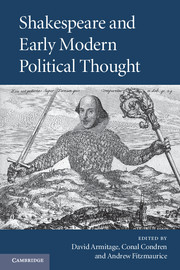Book contents
- Frontmatter
- Contents
- List of contributors
- Acknowledgements
- List of citations and abbreviations
- Introduction
- PART I CONTEXTS
- PART II THE COURT
- 5 Counsel, succession and the politics of Shakespeare's Sonnets
- 6 Educating Hamlet and Prince Hal
- 7 The corruption of Hamlet
- 8 Unfolding ‘the properties of government’: the case of Measure for Measure and the history of political thought
- 9 Shakespeare and the politics of co-authorship: Henry VIII
- PART III THE COMMONWEALTH
- Afterword: Shakespeare and humanist culture
- Index
6 - Educating Hamlet and Prince Hal
Published online by Cambridge University Press: 18 January 2010
- Frontmatter
- Contents
- List of contributors
- Acknowledgements
- List of citations and abbreviations
- Introduction
- PART I CONTEXTS
- PART II THE COURT
- 5 Counsel, succession and the politics of Shakespeare's Sonnets
- 6 Educating Hamlet and Prince Hal
- 7 The corruption of Hamlet
- 8 Unfolding ‘the properties of government’: the case of Measure for Measure and the history of political thought
- 9 Shakespeare and the politics of co-authorship: Henry VIII
- PART III THE COMMONWEALTH
- Afterword: Shakespeare and humanist culture
- Index
Summary
In the final years of the sixteenth century, speculation as to the identity of England's future ruler was both forbidden and rife. In 1593, Peter Wentworth was arrested for discussing the succession with fellow members of Parliament. In 1595, Robert Parsons' treatise A Conference about the Next Succession to the Crowne of Ingland had been provocatively dedicated to the earl of Essex as the man likely ‘to have a greater part or sway in deciding of this great affaire’. Indeed, William Camden claimed, perhaps unfairly, that the earl's followers spent much of 1599 declaring his own right to the crown. As Peter Lake has argued, however, Parsons had a bigger target in his sights than the self-promoting earl. His intention was to ‘create a sense of confusion and impending crisis’ around the claim of the more established candidate, James VI of Scotland. There is some evidence to suggest the Jesuit's success. His intervention triggered a flurry of treatises, including the posthumous publication of Wentworth's Pithie Exhortation to her Majestie (1598). By 1600, Thomas Wilson pronounced that while the crown was ‘not like to fall to the ground for want of heads to wear it’, quite who would succeed ‘is by many doubted’.
While English subjects speculated about their future ruler, William Shakespeare created two very different potential monarchs for the public view: the eponymous prince in Hamlet, which was probably written in 1600–1; and Prince Hal of the second tetralogy. I Henry IV was entered on the Stationers' Register on 25 February 1598.
- Type
- Chapter
- Information
- Shakespeare and Early Modern Political Thought , pp. 119 - 138Publisher: Cambridge University PressPrint publication year: 2009
- 3
- Cited by

